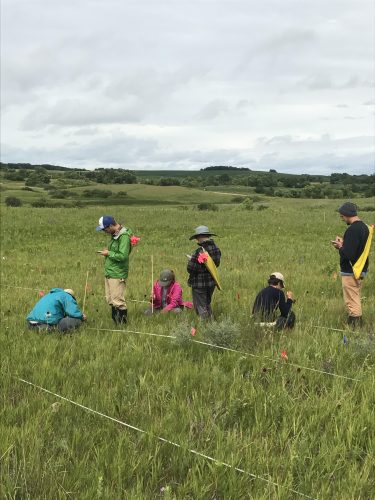This summer, we measured open-pollinated hybrid Echinacea plants in experimental plot 9 at Hegg Lake. The table below shows the number of plants found alive during each search since the experiment started in 2014. Of the surviving plants in 2017, 90% had fewer than 3 leaves, the mean length of the longest basal leaf was 25 cm, and only six plants had more than one basal rosette. This year we searched for plants once then rechecked every position where we didn’t find a plant during our first search. No plants flowered this year.
| Year / Event | Number Alive | % Original remaining | % Of previous year |
| Planting (2014) | 746 | 100 | |
| 2014 | 638 | 85.5 | 85.5 |
| 2015 | 521 | 69.8 | 81.7 |
| 2016 | 493 | 66.1 | 94.6 |
| 2017 | 401 | 53.8 | 81.3 |
This experiment comparing the fitness of Echinacea hybrids with pure-bred E. angustifolia and E. pallida will give insight into the possible consequences of non-native E. pallida being planted in restorations in Minnesota, where E. angustifolia is the only native Echinacea.
Start year: 2014
Location: Hegg Lake Wildlife Management Area — experimental plot 9
Overlapping experiments: Echinacea hybrids — experimental plot 6, Echinacea hybrids — experimental plot 7
Data collected: Rosette number, length of all leaves, herbivory for each plant collected electronically and exported to CGData. Recheck information for plants not found was also collected electronically and stored in CGData.
You can find out more information about experimental plot 9 and flog posts mentioning the experiment on the background page for the experiment.


Leave a Reply